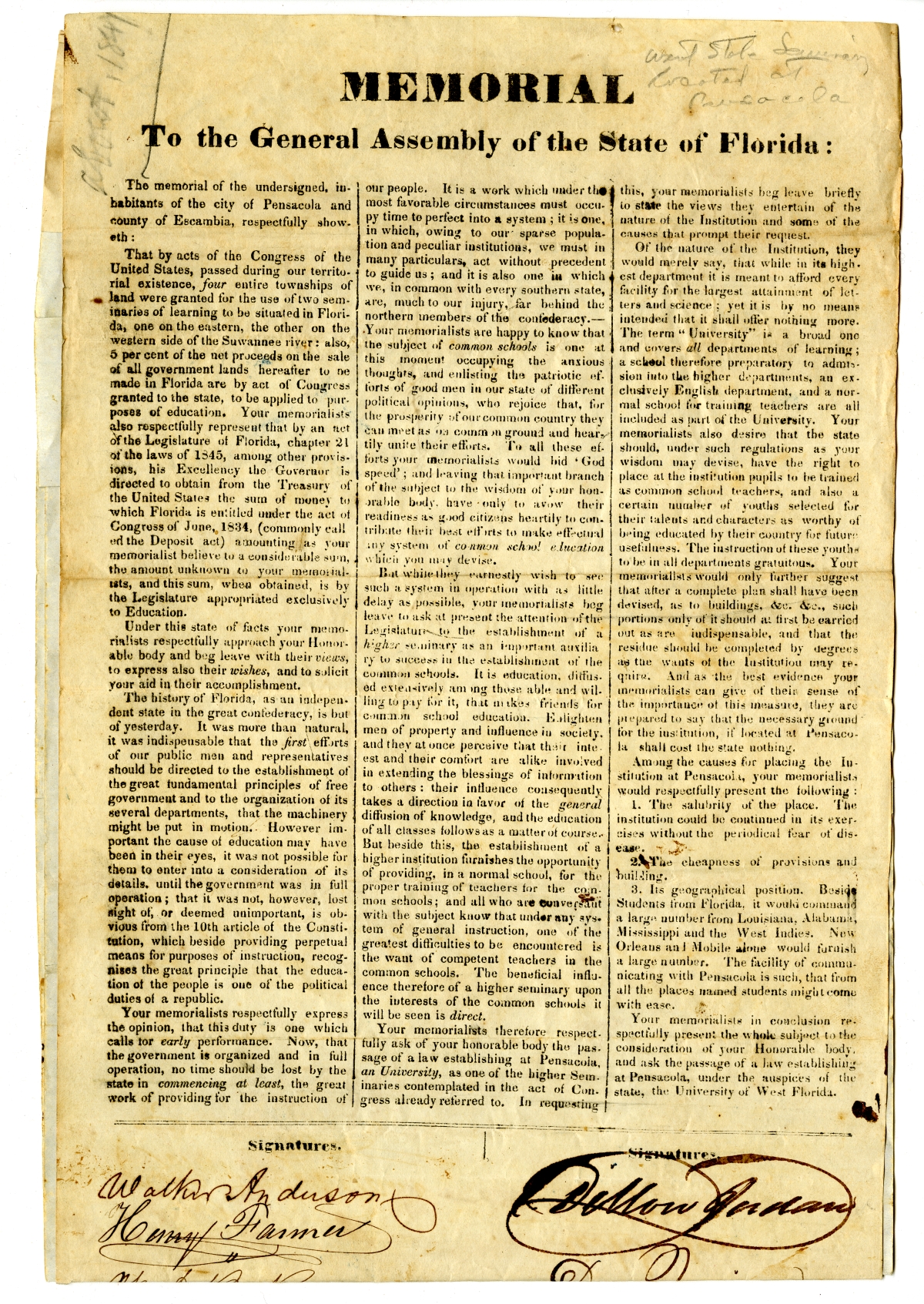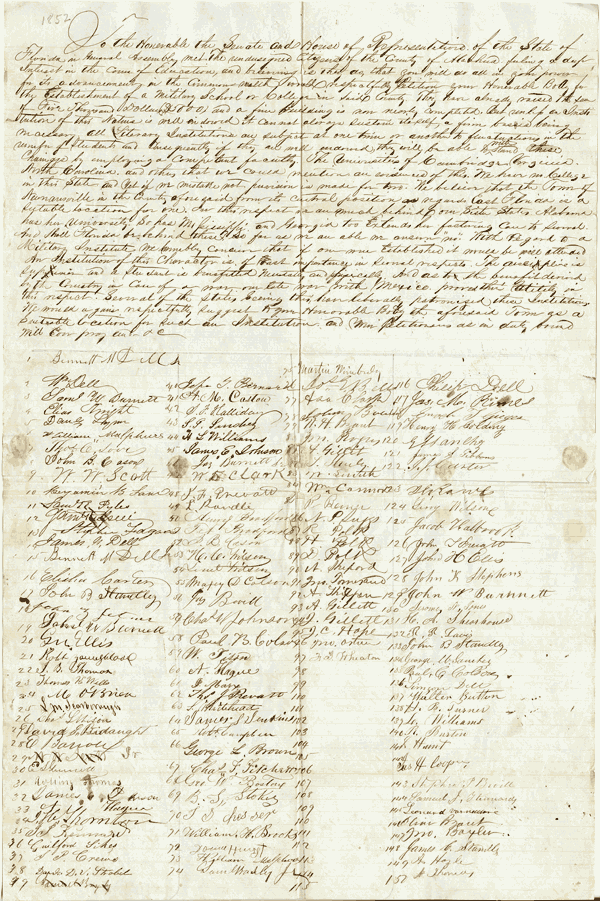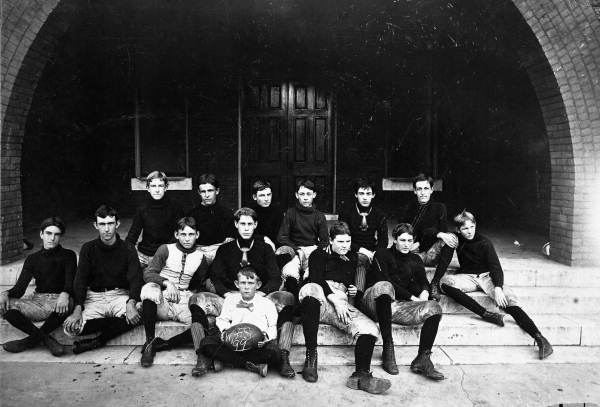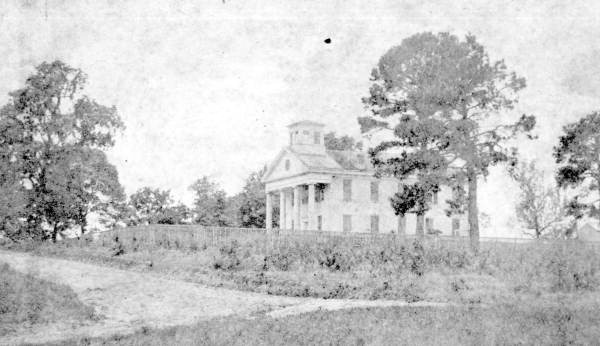Description of previous item
Description of next item
A Home for Higher Learning
Published December 12, 2015 by Florida Memory
It’s hard to imagine Tallahassee without Florida State University or Gainesville without the University of Florida, but how did they get there? Believe it or not, at one time these institutions existed only on paper, and could have been located anywhere in the state. Multiple towns competed for the honor of hosting them, and the Legislature had to make some tough decisions to choose homes for Florida’s first institutions of higher learning.
Florida’s elected representatives recognized the value of higher education early on, but failed to translate their enthusiasm into action during the territorial era. In 1823, the territorial council voted to set aside two townships’ worth of public land to raise money for a seminary of higher learning. In 1836, Governor Richard Keith Call appointed a 14-member board to plan for a University of Florida. Very little concrete action materialized from these efforts, however, and Florida became a state in 1845 still lacking a state college of any kind.
Floridians lamented the state of their educational system. Georgia had had a public university since 1785, while the University of Alabama had been open since 1831. Meanwhile, Florida’s young men and women were obliged to travel outside the state to finish their training, or not receive it at all. In January 1851, the Legislature took action by establishing two seminaries for teacher training, one for each side of the Suwannee River. Beyond this one directive, the act was silent as to where the two schools should be located. The Legislature would have to make that choice once the options were clearer.
Several towns throughout the state took this as their cue to make it very clear why they should be chosen as the site for one of the new seminaries. Several of their petitions to the Legislature have survived and are now part of Record Series 2153 at the State Archives of Florida. In recommending themselves, the petitioners focused on the healthfulness and convenience of their location. Pensacola’s advocates, for example, argued their proximity to the Gulf and points west would attract students from neighboring Alabama, Mississippi, Louisiana, and perhaps even the West Indies. Ocala’s petitioners pointed to their position near the geographic center of the peninsula and the number of stage roads in the area as reasons for the town’s worthiness.

Memorial to the General Assembly of the State of Florida from the citizens of Pensacola, asking that the state seminary west of the Suwannee River be located in Pensacola (1847). Note this petition actually preceded the 1851 act creating the two seminaries. Click the image to enlarge it.
The committees writing these petitions realized, however, that it would take more than a few beautiful descriptive phrases to sway the Legislature. To sweeten the deal, they included offers of land, buildings, and even cash to strengthen their case.
East of the Suwannee River, Ocala in Marion County and Newnansville in Alachua County were the main contenders for a seminary. The Ocala petitioners offered to give the state 16 town lots in Ocala valued at $5,000, plus $1,600 cash, as well as the buildings then being used by the East Florida Independent Institute. The Institute had been established in 1852 by a New Englander named Gilbert Dennis Kingsbury, who went by the name S.S. Burton in Florida. Newnansville did not yet possess anything like the East Florida Independent Institute had to offer, but in their petition the citizens of the town pledged $5,000 toward constructing new facilities. The Legislature ultimately selected Ocala as the site for the state seminary east of the Suwannee, which after a series of transformations and a relocation to Gainesville became the University of Florida.

Petition to Establish the East Florida Seminary in Alachua County, ca. 1852 – Box 3, folder 55, Territorial and Early Statehood Records (Series 2153), State Archives of Florida. Click image to enlarge and view transcript.
West of the Suwannee, Pensacola and Tallahassee were locked into a similar competition. Pensacola’s citizens promised to provide whatever land was necessary to build a seminary, but Tallahassee went much farther. The mayor and city council pledged to donate $10,000 to the cause, made up partly of $7,000 worth of land and buildings already under construction, plus the remainder in cash. City officials also offered to grant the institution an annuity of $1,500. Citizens of nearby Quincy in Gadsden County chimed in with a similar offer of the buildings used by the Quincy Academy, but the petitioners did not commit any specific amount of cash to the project, let alone an annuity. The Legislature chose Tallahassee as the site for the state seminary west of the Suwannee, which ultimately became the Florida State College for Women and later the Florida State University.

Few folks know that Florida State University had a football team well before the school became coeducational (again) in 1947. Prior to its reconstitution as the Florida State College for Women under the Buckman Act in 1905, the West Florida Seminary was coeducational and football was a school sport. This photo of the school’s football team was taken in 1899. The team members are sitting on the steps of College Hall, the seminary’s main building, which stood from its construction in 1891 to 1909, when it was replaced by Westcott Hall, which still stands today.
What state institutions are located near your Florida community? Do you know how long they’ve been around, or how they came to exist? The State Library & Archives is home to a wealth of information on this subject – search Florida Memory, the State Library Catalog, and the Archives Online Catalog to learn more.
Cite This Article
Chicago Manual of Style
(17th Edition)Florida Memory. "A Home for Higher Learning." Floridiana, 2015. https://www.floridamemory.com/items/show/321960.
MLA
(9th Edition)Florida Memory. "A Home for Higher Learning." Floridiana, 2015, https://www.floridamemory.com/items/show/321960. Accessed December 16, 2025.
APA
(7th Edition)Florida Memory. (2015, December 12). A Home for Higher Learning. Floridiana. Retrieved from https://www.floridamemory.com/items/show/321960

 Listen: The World Program
Listen: The World Program
